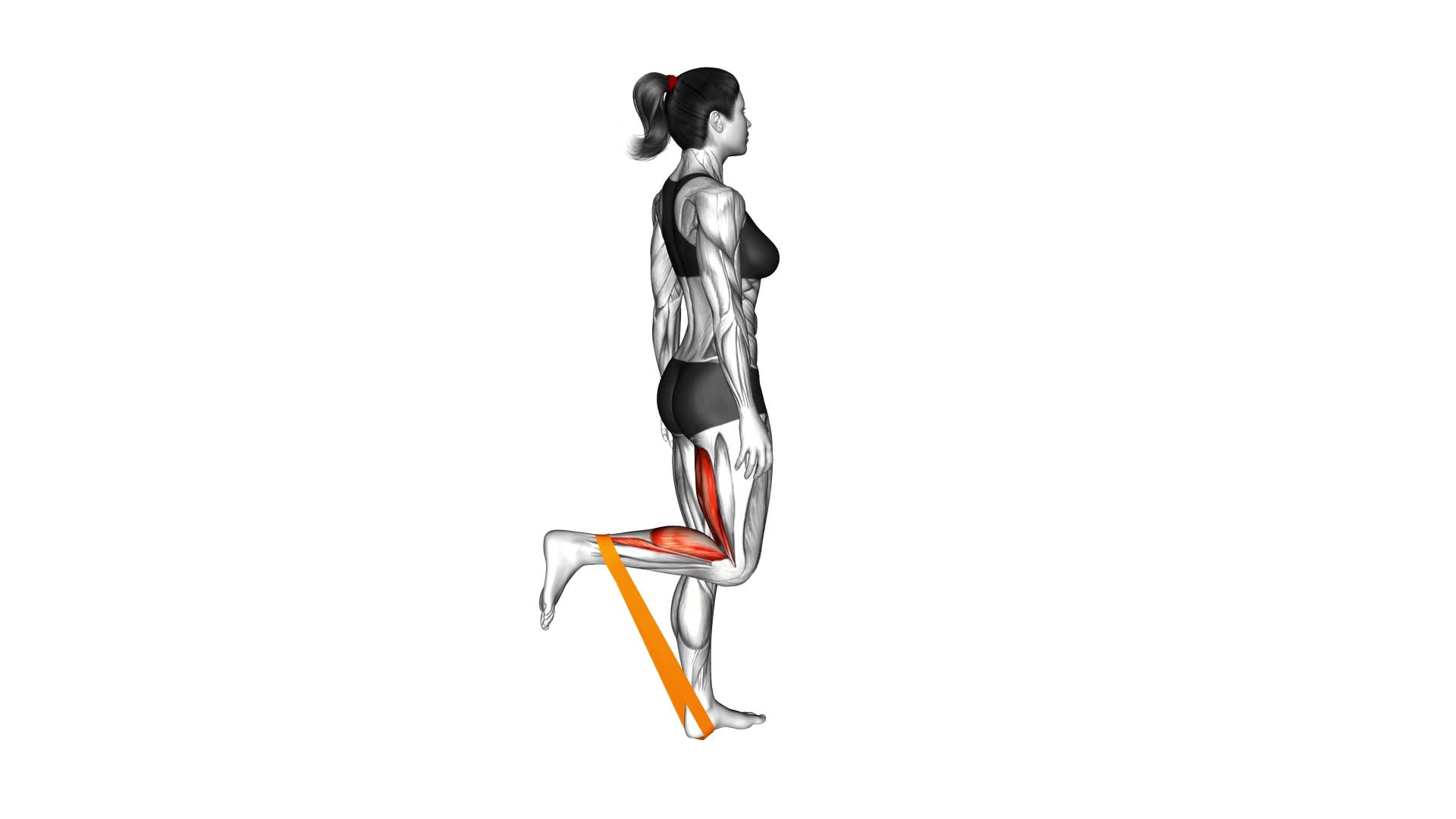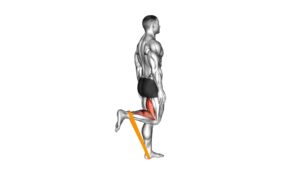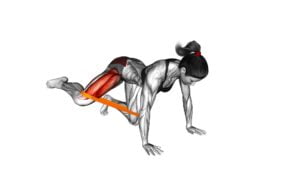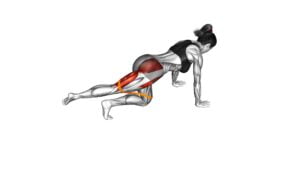Resistance Band Leg Curl (female) – Video Exercise Guide & Tips

Looking to tone and strengthen your legs? The resistance band leg curl is a fantastic exercise that targets your hamstrings and glutes.
Watch This Exercise Video
In this video exercise guide, you'll learn the proper set-up, step-by-step instructions, and common mistakes to avoid.
Plus, we'll share tips for increasing intensity and progression. Whether you're a beginner or experienced, this exercise is perfect for women of all fitness levels.
Get ready to feel the burn and achieve those leg goals!
Key Takeaways
- Resistance band leg curl targets and strengthens hamstrings, glutes, and lower body muscles.
- It is a versatile exercise that can be modified for different fitness levels and goals.
- The exercise improves stability and balance by engaging core muscles.
- Resistance band leg curls can be conveniently done anywhere with a resistance band and stable anchor point.
Benefits of Resistance Band Leg Curl
To maximize the effectiveness of your resistance band leg curl exercise, it's important to understand the benefits it offers.
Resistance band leg curls provide a great way to target and strengthen your hamstrings, glutes, and lower body muscles. One of the main benefits of this exercise is its versatility. You can easily modify the resistance band leg curl to suit your fitness level and goals. For beginners, using a lighter resistance band or adjusting the length of the band can make the exercise more manageable. On the other hand, advanced individuals can increase the resistance or perform the exercise with one leg at a time for an added challenge.
Another benefit of the resistance band leg curl is that it helps improve stability and balance. As you perform the exercise, you engage your core muscles to maintain proper form and control. This not only strengthens your core but also enhances your overall stability and balance.
Moreover, the resistance band leg curl is a convenient exercise that can be done anywhere, anytime. All you need is a resistance band and a stable anchor point to attach it to.
To maximize the effectiveness of your resistance band leg curl, it's important to follow some tips. First, ensure that the resistance band is securely anchored and that it's the appropriate length for your height. Maintain proper form throughout the exercise, keeping your back straight and your core engaged. Control the movement as you curl your legs towards your glutes and slowly return to the starting position. Remember to breathe rhythmically and avoid rushing through the exercise.
Lastly, consider incorporating different variations of the resistance band leg curl into your routine to continuously challenge your muscles and prevent plateauing. By understanding the benefits and implementing these tips, you can make the most out of your resistance band leg curl exercise.
Proper Set-Up and Equipment for Leg Curl
To ensure proper set-up for the leg curl exercise, start by securing the resistance band around a sturdy anchor point, such as a door handle or a heavy piece of furniture. Make sure the band is securely fastened and won't slip during the exercise.
As for equipment options, you can use a looped resistance band or a flat band with handles, depending on your preference and the level of resistance you desire.
Correct Positioning Tips
Ensure you have the proper set-up and equipment for the leg curl by positioning your body correctly. To avoid common mistakes and maximize the effectiveness of this exercise, follow these correct positioning tips.
Start by lying face-down on a mat with your legs fully extended and a resistance band securely wrapped around your ankles. Place your hands underneath your shoulders, palms down, and engage your core muscles. Keep your legs straight and parallel to each other throughout the exercise.
To increase intensity, you can adjust the tension of the resistance band by either choosing a band with higher resistance or by adjusting the length of the band. Make sure to maintain proper form and control throughout the movement to prevent any strain or injury.
Recommended Equipment Options
Choose the appropriate equipment for your leg curl to ensure proper set-up and maximize the effectiveness of the exercise.
When it comes to resistance band exercises, there are different resistance levels available to suit your fitness level and goals. Resistance bands come in various colors or levels of resistance, ranging from light to heavy.
Beginners may start with a lighter resistance band, while more advanced individuals can opt for a heavier one to challenge themselves.
It's important to choose a resistance band that provides enough tension to work your muscles effectively but not too much that it strains or hinders your form.
Experiment with different resistance levels to find the one that allows you to perform the leg curl with proper technique and without compromising your safety.
Step-by-Step Guide for Performing Leg Curl
Now, let's focus on the key points you need to know when performing a leg curl.
First, mastering the correct form and technique is crucial to maximize the benefits of this exercise.
Secondly, understanding the benefits of leg curls, such as strengthening the hamstrings and improving lower body stability, can motivate you to incorporate this exercise into your routine.
Lastly, we'll explore variations and modifications that can add variety and challenge to your leg curl workouts.
Form and Technique
To properly execute the resistance band leg curl, begin by lying on your stomach with the band securely fastened around your ankles. Here's how to perform the leg curl with proper form and technique:
- Position yourself: Lie flat on your stomach, legs straight, with the band attached to your ankles.
- Engage your core: Squeeze your glutes and tighten your abdominal muscles to stabilize your body.
- Curl your legs: Bend your knees, bringing your heels towards your glutes while keeping your upper body still.
- Pause and squeeze: Hold the curled position for a second, focusing on contracting your hamstrings.
- Slowly extend your legs: Straighten your knees to return to the starting position.
- Repeat for the recommended number of repetitions.
Benefits of Exercise
To fully maximize the benefits of the resistance band leg curl, make sure to engage both your hamstrings and glutes throughout the exercise. This exercise offers numerous health benefits, such as strengthening and toning your leg muscles. By targeting your hamstrings and glutes, you can improve your lower body's stability and overall strength.
Additionally, the resistance band leg curl helps to enhance your athletic performance, making you more efficient in activities like running, jumping, and squatting. Not only does this exercise benefit your physical health, but it also has mental benefits. Regularly performing the resistance band leg curl can boost your mood, reduce stress, and increase your overall sense of well-being.
Variations and Modifications
Continuing from the previous subtopic, you can enhance the resistance band leg curl exercise by exploring various variations and modifications. Here are three ways you can mix up your leg curl routine:
- Single leg curl: Instead of using both legs simultaneously, perform the exercise with one leg at a time. This variation increases the intensity and challenges your balance and stability.
- Seated leg curl: If you don't have a bench or stability ball, you can still perform the leg curl exercise while seated on a chair or the edge of a bed. Attach the resistance band to a secure point in front of you and curl your legs towards your body.
- Elevated leg curl: Elevate your upper body on an incline bench or stability ball to target your hamstrings from a different angle. This modification adds an extra challenge and helps engage your core muscles as well.
Common Mistakes to Avoid During Leg Curl
When performing the leg curl exercise, be mindful of these common mistakes to avoid. Proper technique is crucial to ensure that you engage the correct muscles and prevent any potential injuries.
One common mistake is using momentum instead of controlled movements. It's important to focus on the contraction of your hamstring muscles and avoid swinging your legs up using momentum.
Another mistake is lifting your hips off the ground. This not only reduces the effectiveness of the exercise but also puts unnecessary strain on your lower back. To avoid this, keep your hips firmly on the ground throughout the movement.
Additionally, make sure to maintain a neutral spine position and avoid arching your back.
Lastly, avoid using weights that are too heavy for your current strength level. Using excessive weight can compromise your form and increase the risk of injury.
By avoiding these common mistakes and focusing on proper technique, you can maximize the benefits of the leg curl exercise.
Now, let's move on to some tips for increasing intensity and progression.
Tips for Increasing Intensity and Progression
To increase the intensity and progression of your resistance band leg curl exercise, you can incorporate these effective tips:
- Increase resistance: As you become stronger and more comfortable with the exercise, it's important to challenge yourself by using a resistance band with higher tension. This will force your muscles to work harder and promote muscle growth.
- Advanced techniques: Once you have mastered the basic leg curl, you can try incorporating advanced techniques to further increase the intensity. One option is to perform the exercise on a stability ball, which adds an element of instability and engages more muscles. Another option is to perform the leg curl with a single leg instead of both, which requires more balance and activates the muscles more intensely.
- Progressive overload: To continue making progress, it's important to gradually increase the demands placed on your muscles. You can achieve this by gradually increasing the number of repetitions, sets, or resistance used in your resistance band leg curl exercise. This progressive overload will ensure that your muscles continue to adapt and grow stronger over time.
Alternative Exercises to Complement Leg Curl
For a well-rounded lower body workout, try incorporating other exercises in addition to the resistance band leg curl.
While the resistance band leg curl is a great exercise to target the hamstrings, there are alternative exercises that can complement and enhance your leg workout.
One alternative exercise is the stability ball hamstring curl. This exercise requires lying on your back with your heels on a stability ball and lifting your hips off the ground. Then, bend your knees and roll the ball towards your glutes, engaging your hamstrings. This exercise not only targets the hamstrings but also engages the core and glutes for added stability.
Another alternative exercise is the Romanian deadlift. This exercise focuses on the posterior chain, including the hamstrings, glutes, and lower back. To perform this exercise, stand with your feet hip-width apart, holding a barbell or dumbbells in front of your thighs. Hinge at the hips, keeping your back straight, and lower the weight as far as your flexibility allows. Then, engage your hamstrings and glutes to return to the starting position.
Incorporating these alternative exercises to complement the resistance band leg curl will help target different muscles in your lower body and provide a well-rounded workout. Remember to always consult with a fitness professional before starting any new exercise routine.
Frequently Asked Questions
How Long Should I Hold the Contraction at the Top of the Leg Curl Movement?
When performing resistance band leg curls, it's important to know how long to hold the contraction at the top of the movement. The duration of the contraction can vary depending on your fitness level and goals. Generally, it's recommended to hold the contraction for 1-2 seconds at the top to fully engage and activate your hamstring muscles.
This helps to strengthen and tone your lower body. Remember to focus on maintaining proper form and breathing throughout the exercise for optimal results.
Can Resistance Bands Be Used for Other Lower Body Exercises?
Resistance bands aren't just limited to lower body exercises like leg curls. They can also be used for various upper body exercises, providing a versatile workout option.
The benefits of using resistance bands for upper body exercises include increased muscle strength, improved posture, and enhanced range of motion.
Is It Safe to Perform Resistance Band Leg Curls if I Have Knee Pain or Injury?
If you have knee pain or injury, it may not be safe to perform resistance band leg curls. It's important to listen to your body and avoid exercises that exacerbate your pain.
Instead, consider alternative exercises that target the same muscle groups without putting strain on your knees, such as seated leg curls using a machine or glute bridges.
Resistance bands can still be beneficial for strengthening your legs, but make sure to choose exercises that are safe for your condition.
How Many Sets and Repetitions Should I Do for Optimal Results?
To maximize your results with resistance band leg curls, focus on progressing gradually. Start with a comfortable number of sets and repetitions, such as 2 sets of 10 reps. As you get stronger and more comfortable, gradually increase the intensity by adding more sets or reps. This will help build strength and improve muscle endurance.
The benefits of resistance band leg curls include targeting your hamstrings and glutes, improving lower body strength and stability, and increasing flexibility.
What Are the Different Resistance Levels of Resistance Bands and How Do I Know Which One to Use for Leg Curls?
To choose the right resistance band for leg curls, you need to know the different resistance levels.
Resistance bands come in various levels, such as light, medium, and heavy. The level you choose depends on your strength and fitness goals.
Light bands offer less resistance, while heavy bands provide more challenge. Start with a lighter band and gradually increase the resistance as you get stronger.
Conclusion
In conclusion, the resistance band leg curl is a highly effective exercise for strengthening and toning the leg muscles, particularly the hamstrings. By following the proper set-up and technique, avoiding common mistakes, and incorporating tips for increasing intensity and progression, individuals can maximize the benefits of this exercise.
Additionally, alternative exercises can be included to further enhance the leg curl workout routine. So grab your resistance band and start incorporating the leg curl into your fitness regimen for stronger, more defined legs.

Author
Years ago, the spark of my life’s passion ignited in my mind the moment I stepped into the local gym for the first time. The inaugural bead of perspiration, the initial endeavor, the very first surge of endorphins, and a sense of pride that washed over me post-workout marked the beginning of my deep-seated interest in strength sports, fitness, and sports nutrition. This very curiosity blossomed rapidly into a profound fascination, propelling me to earn a Master’s degree in Physical Education from the Academy of Physical Education in Krakow, followed by a Sports Manager diploma from the Jagiellonian University. My journey of growth led me to gain more specialized qualifications, such as being a certified personal trainer with a focus on sports dietetics, a lifeguard, and an instructor for wellness and corrective gymnastics. Theoretical knowledge paired seamlessly with practical experience, reinforcing my belief that the transformation of individuals under my guidance was also a reflection of my personal growth. This belief holds true even today. Each day, I strive to push the boundaries and explore new realms. These realms gently elevate me to greater heights. The unique combination of passion for my field and the continuous quest for growth fuels my drive to break new ground.



